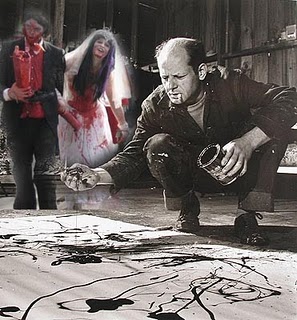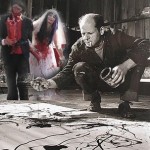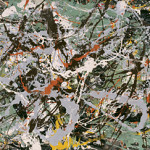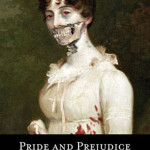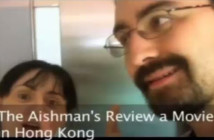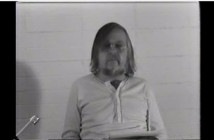While on a hike in the deep woods of Brooklyn, I found some split open trash bags with paper pouring out. Covered in dried blood and with multiple missing pages, I saw it was a journal/tactical notebook/garbage. Here is some of the reconstructed text as far as I could assemble it:
Modernist Painting and the Undead Plague
By Dr. Hide and Mr. Greenberg
1960/2010
Modernism includes more than art, literature and zombies. By now it covers almost the whole of what is truly alive in our culture and with the recent resurgence of walking dead; most of what is undead in our culture as well. It happens, however, to be very much of a historical novelty as most of civilization is now in full decay due to the rapid speed at which the plague is spreading. Western civilization is not the first civilization to turn around and question its own foundations, but in a desperate attempt to understand how things could have gone so wrong, Western civilization is the one that has gone furthest in doing so. I identify Modernism with the intensification, almost the exacerbation, of this self-critical tendency that began with the philosopher Kant. Because he was the first to criticize the means itself of criticism, I conceive of Kant as, the first real Modernist and either the first zombie killer or in fact, as some have surmised, the patient zero of the zombie plague that currently threats all of civilization.
The essence of both Modernism and the solution to the zombie plague lies, as I see it, in the use of characteristic methods of undead extermination to criticize the discipline of zombie killing itself, not in order to subvert it but in order to entrench it more firmly in its area of death dealing competence. Kant used logic to establish the limits of logic, and while he withdrew much from its old jurisdiction, logic was left all the more secure in what there remained to it. However, history has now shown that Kant himself was blissfully unaware of the true power his incantations held and only generations later when Kant’s words were twisted and perverted by mystics like Schopenhauer and Sorcerer Supreme Nietzsche did the undead throngs begin to erupt in numbers to great to be stopped.
How can we forget "The Birth of Tragedy from the Spirit of the Undead" were Nietzsche wrote:
It was soon after Nietzsche’s declaration of the victory over optimism, the reports of walking dead in the local paper rose from a few occasional sightings that were frequently confused with people who were simply depressed or feeling ill; to the full blown plague of undead we now have to deal with on a daily basis. (Where they have come from is still not known, but the fact that their appearance so closely matches with the writings of Nietzsche who maintains a quasi-mystical control over the mindless zombies from beyond the grave, cannot be coincidental.)
The self-criticism of Modernism grows out of, but is not the same thing as, the criticism of the Enlightenment (The Enlightenment is the name historians have given to time directly preceding our Modern, zombie-plagued era when lycanthropes ruled the world through brutal, feral force. It was brave French revolutionaries who discovered that the only way to effectively kill the shape-shifting monarchy was to cut of their heads while they were in human form. Many revolutionaries fell before the claws of Louis XVI and his she-wolf bride Marie-Antoinette before the cursed family found their heads beneath the guillotine.) The Enlightenment criticized the ruling werewolf clans from the outside, the way criticism in its accepted sense does; Modernism has no choice but to criticize from the inside because most of society is now part of the zombie plague we are in fact trying to eradicate. It seems natural that this new kind of criticism should have appeared first in philosophy since most of the first zombies were philosophers who fell prey to their own dark magics, but as the 18th century wore on, it entered many other fields. A more rational justification had begun to be demanded of every formal social activity, and Kantian self-criticism began infecting and turning every other discipline.
[Pages too covered in blood to be read]
Zombie hunting in its latest phase has not abandoned the notion that zombies can be turned back into functioning human beings. What both Modernist painting and the art of zombie killing have abandoned in principle is the representation of the kind of space that recognizable objects or the undead can inhabit. To achieve autonomy, culling the undead has had above all to divest itself of everything it might share with normalized society that seeks to care for its sick and weak. The plague can not be turned back by trying to help those that have been turned and are now mindlessly undead, but must instead rely on the retrenching in the essence of the art of zombie killing set forth by those French that ended the age of "Enlightenment": beheading. The undead are easily tricked, confused, trapped, hacked up, stabbed, lit on fire, and otherwise mangled, but only beheading truly represents the "pure" essence of zombie killing.
[Pages too shredded to be read]
Postscript (1978)
I want to take this chance to correct an error, one of interpretation and not of fact. Many readers, though by no means all, seem to have taken the 'rationale' of Modernist art outlined here as representing a position adopted by the writer himself that is, that what he describes he also advocates. This may be a fault of the writing or the rhetoric. Nevertheless, a close reading of what he writes will find nothing at all to indicate that he subscribes to, believes in, the things that he adumbrates. I in no way am implying that anyone’s head should be cut off. The writer is trying to account in part for how most of the very best art of zombie killing of the last hundred-odd years came about, but he's not implying that that's how it had to come about, much less that that's how the best art still has to come about. The philosopher or art historian who can envision me — or anyone at all — arriving at such violent judgments in this way reads shockingly more into himself or herself than into my article.
- Jackson Pollock shortly before being eaten by a Zombie wedding party.
- Jackson Pollock, Untitled (Green Silver), ca. 1949. on Paper
- Read Clement Greenberg’s original “Modernist Painting” 1960 which was mashed up with zombie nonsense.
Images via Google.

